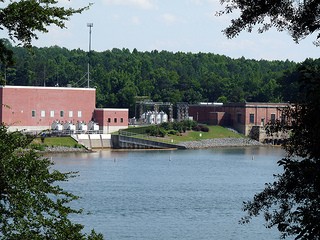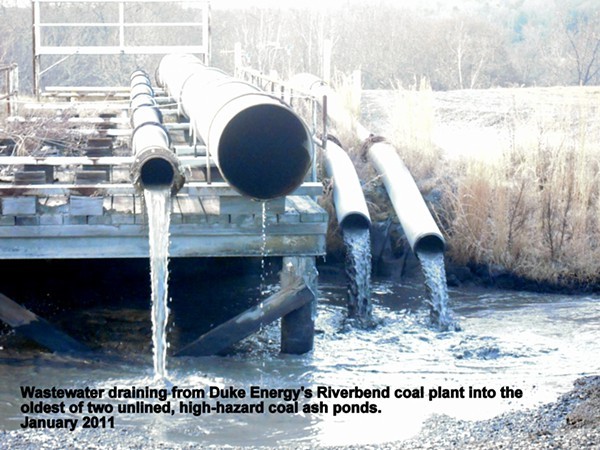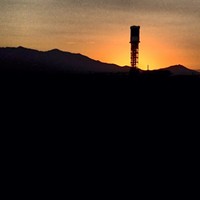Listen, I didn't mean to become the Queen of Coal Ash, but since I am, I feel obligated to remind y'all of the finer details involved in the ongoing melodrama of coal ash pollution in the U.S. and North Carolina.
And since we've got some real American royalty in town today - Robert F. Kennedy Jr., of the Waterkeeper Alliance - discussing Crown Town's coal ash issues, and since I got the title of Queen from from the Central Piedmont Sierra Club because I've been writing about the stuff for Creative Loafing for more than four years, I figured we'd give y'all a royal history lesson. (Look for news of RFK Jr.'s press conference later today.)
Coal ash is a big deal nationally and statewide. With Congress taking up the coal ash issue this week, debating a bill that would essentially prevent regulation of coal ash pollution federally, and the North Carolina General Assembly actively weakening environmental regulations as if we can buy another water source at Walmart, you'd think folks would be boned-up on coal ash. You'd think folks would give a shit about what's in their water, or that they'd notice a couple of coal ash ponds next door. But, alas, collective memory is short, and the water looks fine.
So, let's bolster the collective memory with a brief history of Charlotte's coal ash issues, shall we? We shall ...
- Starting sometime in the 1800s, drinking water is pumped from the Catawba River via the Catawba River Pump Station, in Charlotte, though the river has been an important drinking water source since time immemorial.
- Rhiannon Fionn
- Catawba River Pump Station
- In 1924, Duke Energy constructs Mountain Island Hydroelectric Dam, flooding the Catawba River to create Mountain Island Lake. The original Catawba River Pump Station is also flooded, so a new one is erected. (There's an even newer one in the same location today.)
- In 1929, Duke Energy's Riverbend coal plant comes online just in time for the stock market crash that shoves the United States into the Great Depression.
- In 1954, after the Depression and World War II, residents of the mill-style village that surrounded the plant - the same community that first built the plant, then ran it - begin complaining about "the plant's fly ash problem," (fly ash is a type of coal ash) according to the 1984 book Coming Home, found in Duke Energy's company library. That same year, the village is sold and moved, house by house.
- In 1957, the company builds its first of two unlined coal ash waste ponds. They catch the slurry that's created when coal fly ash (again, just another way of saying coal ash) is watered down in an effort to prevent it from escaping the plants' smoke stacks. Until a couple of years ago, they also caught waste water from the plant (think sewage). Its surface takes up 41 acres, and it is 80-feet deep.
- In 1963, the Clean Air Act is established.
- In 1972, the Federal Water Pollution Control Act of 1948 is amended to become the Clean Water Act.
- In 1986, Duke Energy adds a second, 28-acre, 70-foot-deep unlined coal ash pond to the Riverbend property. Man-made, earthen berms hold both ponds in place. The older pond fills up so much that roughly every 4 years it has to be excavated to create room for more coal ash.
- In 2000, the energy and waste management industries make a deal with the U.S. Environmental Protection Agency: The agency will promote the beneficial reuse (think concrete) of coal ash, states will retain the right to regulate coal ash, and companies will dig groundwater monitoring wells around their coal ash ponds and begin self-monitoring contaminants.
- In the 2000s, the Stonewater neighborhood goes up in Mount Holly (just a stone's throw from Charlotte) directly across the street from the coal ash ponds. Its residents complain about black dust coating their property.
- In December 2008, a massive coal ash disaster occurs in Kingston, Tenn. That same month, Duke Energy finally digs those groundwater monitoring wells around Riverbend's coal ash ponds, eight years after companies agreed to dig the wells.
- Also in 2008, American Rivers deems the Catawba River the "most endangered river in the country."
- 2009 was a big year for Riverbend, and not only because I began stalking the plant like an ex-boyfriend. It's the year that the U.S. Environmental Protection Agency begins investigating the plant's coal ash ponds, ultimately deeming them a "high hazard," which means people would likely die if they burst ... though engineering reports say that shouldn't happen. It's also the year that Appalachian Voices documents groundwater contamination beneath 13 coal ash ponds in North Carolina, including at Riverbend. And - there's more! Also in 2009: We learn that North Carolina has more high-hazard coal ash ponds than any other state. Holla! (Oh, wait. That's not good.)
- In 2010, North Carolina updates its coal ash regulations, requiring Duke Energy to sink more groundwater wells at its coal plants along the Catawba River - three are near Charlotte, and they all have coal ash ponds or other coal ash waste storage closeby.
- Also in 2010, Duke Energy's spending on lobbying against coal ash regulation spikes, according to OpenSecrets.org.
- In 2011, the Union of Concerned Scientists categorizes the Catawba River as "stressed," specifically because of the energy industry's usage of the river's waters.
- In 2012, the Catawba Riverkeeper notices that Riverbend's coal ash ponds are leaking where they shouldn't be, Duke University releases a report stating that the coal ash ponds are, in fact, polluting North Carolina waterways with "arsenic, selenium and other toxic elements," and the state decides that it doesn't see any need to clean up coal ash impoundments.
- In 2013, Duke Energy announces it will close its Riverbend coal plant on April Fool's Day, and it isn't joking. It also discusses plans it and the state are working on to close the coal ash ponds, though the state later admits that it isn't doing anything about coal ash.
- Also this year, the N.C. General Assembly decides it should study coal ash itself, and the lawsuits begin to fly, first from environmental groups, then the state of North Carolina.
- In recent history, from last week, the state announces its intention to settle its lawsuits with Duke Energy over coal ash contamination along with the start of a public comment period that ends August 14. The same week, allegations of Duke Energy's campaign donations being the source of the settlement also come forth.
- And now, 84 years after Riverbend began combusting coal, a Kennedy is coming to visit! That's pretty special, y'all.

Editor's note: This story originally credited Richard Nixon as the president who oversaw the 1963 Clean Air Act. Nixon didn't become president until 1969.






